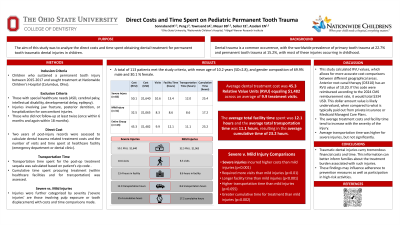Trauma
11 - Direct Costs and Time Spent on Pediatric Permanent Tooth Trauma


Ryan Sonnabend, DDS
Resident
The Ohio State University and Nationwide Children's Hospital
The Ohio State University and Nationwide Children's Hospital
Columbus, Ohio, United States
Ehsan N. Azadani, DDS, MS
Assistant Professor and Attending
The Ohio State University and Nationwide Children's Hospital
The Ohio State University and Nationwide Children's Hospital
Columbus, Ohio, United States
Kim Hammersmith, DDS, MPH, MS
Program Director
The Ohio State University and Nationwide Children's Hospital
The Ohio State University and Nationwide Children's Hospital
Columbus, Ohio, United States
Presenting Author(s)
Research Mentor(s)
Program Director(s)
Purpose: The aim of this study was to analyze the direct costs and time spent obtaining dental treatment for permanent tooth trauma.
Methods: This retrospective study assessed the direct cost and time spent on the treatment of dental trauma during the 2 years post-injury for children (under 18 years old) who sustained a permanent tooth injury between 2015-2017.
Results: A total of 113 patients met the inclusion criteria, with a mean age of 10.2 years. The average dental treatment cost was 45.3 Relative Value Units (RVU) equaling $1482.10 across an average of 9.9 treatment visits. The average total facility time spent was 12.1 hours and the average total transportation time was 11.1 hours, resulting in the average cumulative time of 23.2 hours. On average, severe injuries (pulp exposures and tooth displacements) incurred higher cost (50.1 RVU, $1639.70) than milder injuries (32.5 RVU, $1065.10), required more visits (10.6) than mild injuries (8.3), resulted in longer facility time (13.4 hours) than mild injuries (8.6 hours), higher transportation time (12.0 hours) than mild injuries (8.6 hours) and spent more cumulative time on treatment (25.4 hours) than mild injuries (17.2 hours).
Conclusion: Traumatic dental injuries carry significant financial and time burdens. The direct costs and time required tend to increase with the severity of the injury. This information can better inform families about the treatment burden associated with such injuries, enabling them to make more informed decisions. Furthermore, it may influence their adherence to prevention measures as well as their participation in high-risk activities.
Identify Supporting Agency and Grant Number:

.jpg)